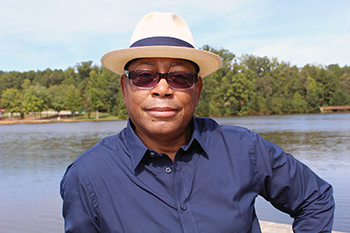Chronic Myeloid Leukemia Survivor
Persistence and Dedication Empower Survivor to Help Others
 For Mel Mann, receiving a chronic myeloid leukemia (CML) diagnosis in 1995 at 37 was not just life-changing for him, but also for his family and others. For more than two decades since his diagnosis, Mel has advocated to improve the lives of people with blood cancer by raising awareness about the need for bone marrow donors.
For Mel Mann, receiving a chronic myeloid leukemia (CML) diagnosis in 1995 at 37 was not just life-changing for him, but also for his family and others. For more than two decades since his diagnosis, Mel has advocated to improve the lives of people with blood cancer by raising awareness about the need for bone marrow donors.
A lasting backache, general fatigue and no endurance prompted me to visit the clinic at the Michigan military base where I was stationed with my wife and five-year-old daughter. Results from blood tests and a bone marrow aspiration and biopsy confirmed I had chronic myeloid leukemia (CML) in the chronic phase.
The prognosis was grim: three years. Even worse, the
doctor couldn’t tell me where I was within that three-year outlook. I was in denial. I visited a larger military clinic for a second opinion. Doctors there confirmed the diagnosis, so I accepted it.
The doctor felt my best chance for long-term survival was a bone marrow transplant. Though it came with significant risks, I was willing to try so the search began to find a match through the national bone marrow registry. I soon learned that was easier said than done. There were very few African Americans in the national bone marrow registry, and I was told I had less than a one percent chance of finding a match. That wasn’t good enough for me, so I got involved.
I held bone marrow drives on my base, at the mall and in churches. Local television stations promoted them. My military colleagues helped, flying me to bases in other parts of the country to organize drives while others managed drives in different parts of the world for me. Getting people registered wasn’t as easy as today’s cheek swab. Back when I was diagnosed, donors had to give blood.
Meanwhile, other things were happening. I began treatment to bring down my white blood cell count, then moved to a form of immunotherapy. My medical status prevented me from being on active duty and deployment, and the military began the long process of putting me on medical retirement. We moved to Georgia to have the support of my wife’s family. I can’t say enough about having support. Just talking about my situation with family and friends was so valuable for my mental wellness.
During one of the bone marrow drives in Georgia, a man told me about his leukemia treatment at a major cancer center in another state. He encouraged me to go there and learn about the medications they had access to. I hadn’t yet found a donor match, so I flew out for a consultation and discovered clinical trials. The doctor I saw enrolled me in one that then turned into others when my CML didn’t respond to the medications being used.
I reached the “three-year-mark” with no real solution. I was losing weight and becoming more fatigued. Sleep and coffee made no difference. My doctor felt the only hope was a clinical trial drug that wasn’t yet available. Eight months later – and in my opinion, just in time – I became part of a Phase I clinical trial. I relocated to the cancer center with the trial in August 1998 for three months.
The trial drug was an oral targeted therapy, and it worked for me. It put me into major remission. Just 10 months after starting it, I ran a full 26.2-mile marathon in Alaska. In fact, it still works for me all these years later. It’s no longer part of a clinical trial. It was approved as a treatment a few years after I began taking it.
If you can believe it, my donor match was never found so I’m especially blessed this medication works for me. It has given me more years than I could have imagined — enough to see our little girl grow up to be a doctor. I still take my daily pill like clockwork, which is really important. I’ve seen firsthand how CML is able to evolve and take someone out of remission when they don’t take it as prescribed. I’m not willing to jeopardize that.
The need for more donors is still great. My wife and I continue to work with many organizations, such as The Leukemia & Lymphoma Society and Be the Match, to raise awareness.
I’m glad there are researchers who are working on these therapies and that people who are diagnosed with CML today have more treatment options than I did. I wish I’d have known about clinical trials when I was first diagnosed. Just knowing they might be an option would have given me hope.
I lead a healthy lifestyle of a balanced diet, exercise and fresh air. I also keep my follow-up appointments to monitor how the CML is reacting to the treatment. Depending on the protein levels in my blood work, I may be able to stop the treatment someday but, at this point, why rock the boat?


